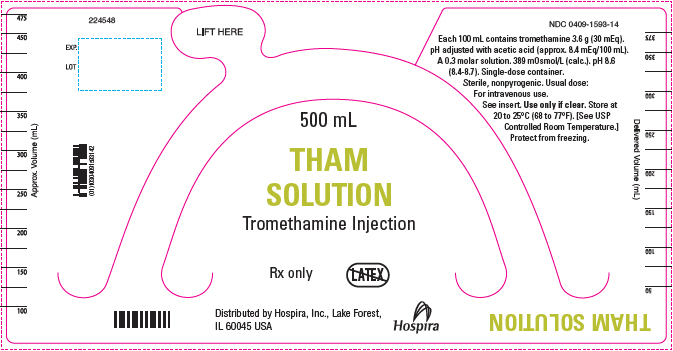Tham
Generic name: Tromethamine
Drug classes: Minerals and electrolytes, Miscellaneous genitourinary tract agents
Medically reviewed by A Ras MD.
What is Tham used for?
Tham is a prescription medicine that is used to treat or prevent acid problems in the blood.
Description
Tham Solution (tromethamine injection) is a sterile, non-pyrogenic 0.3 M solution of tromethamine, adjusted to a pH of approximately 8.6 with glacial acetic acid. It is administered by intravenous injection, by addition to ACD blood for priming cardiac bypass equipment and by injection into the ventricular cavity during cardiac arrest.
Each 100 mL contains tromethamine 3.6 g (30 mEq) in water for injection. The solution is hypertonic 389 mOsmol/L (calc.). pH 8.6 (8.4-8.7).
The solution contains no bacteriostat, antimicrobial agent or added buffer (except acetic acid for pH adjustment) and is intended only for use as a single-dose injection. When smaller doses are required the unused portion should be discarded.
Tham solution is a parenteral systemic alkalizer and fluid replenisher.
Tromethamine, USP (sometimes called “tris” or “tris buffer”) is chemically designated 2-amino-2-(hydroxymethyl)-1, 3-propanediol, a solid readily soluble in water, also classified as an organic amine buffer. It has the following structural formula:

Water for Injection, USP is chemically designated H20.
Before taking Tham, tell your doctor:
For all patients taking Tham:
- If you are allergic to Tham; any part of this medicine; or any other drugs, foods, or substances. Tell your doctor about the allergy and what signs you had.
- If you are not able to pass urine.
Children:
- This medicine is not for newborns who have any of these problems: High blood carbon dioxide levels or too much salicylate in the body.
This is not a list of all drugs or health problems that interact with this medicine.
Tell your doctor and pharmacist about all of your drugs (prescription or OTC, natural products, vitamins) and health problems. You must check to make sure that it is safe for you to take Tham with all of your drugs and health problems. Do not start, stop, or change the dose of any drug without checking with your doctor.
What are some things I need to know or do while I take Tham?
For all patients taking Tham:
- Tell all of your health care providers that you take Tham. This includes your doctors, nurses, pharmacists, and dentists.
- Have blood work checked as you have been told by the doctor. Talk with the doctor.
- Check your blood sugar as you have been told by your doctor.
- Tell your doctor if you are pregnant or plan on getting pregnant. You will need to talk about the benefits and risks of using Tham while you are pregnant.
- Tell your doctor if you are breast-feeding. You will need to talk about any risks to your baby.
Children:
- Use with care in children. Talk with the doctor.
How is Tham best taken?
Use Tham as ordered by your doctor. Read all information given to you. Follow all instructions closely.
- It is given as an infusion into a vein over a period of time.
What are the side effects of Tham that I need to call my doctor about immediately?
WARNING/CAUTION: Even though it may be rare, some people may have very bad and sometimes deadly side effects when taking a drug. Tell your doctor or get medical help right away if you have any of the following signs or symptoms that may be related to a very bad side effect:
- Signs of an allergic reaction, like rash; hives; itching; red, swollen, blistered, or peeling skin with or without fever; wheezing; tightness in the chest or throat; trouble breathing, swallowing, or talking; unusual hoarseness; or swelling of the mouth, face, lips, tongue, or throat.
- Signs of low blood sugar like dizziness, headache, feeling sleepy, feeling weak, shaking, a fast heartbeat, confusion, hunger, or sweating.
- Signs of high potassium levels like a heartbeat that does not feel normal; feeling confused; feeling weak, lightheaded, or dizzy; feeling like passing out; numbness or tingling; or shortness of breath.
- Trouble breathing, slow breathing, or shallow breathing.
- Shortness of breath, a big weight gain, or swelling in the arms or legs.
- Fever.
- This medicine may cause tissue damage if the drug leaks from the vein. Tell your nurse if you have any redness, burning, pain, swelling, blisters, skin sores, or leaking of fluid where the drug is going into your body.
What are some other side effects of Tham?
All drugs may cause side effects. However, many people have no side effects or only have minor side effects. Call your doctor or get medical help if you have any side effects that bother you or do not go away.
These are not all of the side effects that may occur. If you have questions about side effects, call your doctor. Call your doctor for medical advice about side effects.
You may report side effects to the FDA at 1-800-332-1088. You may also report side effects at https://www.fda.gov/medwatch.
If overdose is suspected:
If you think there has been an overdose, call your poison control center or get medical care right away. Be ready to tell or show what was taken, how much, and when it happened.
How do I store and/or throw out Tham?
- If you need to store Tham at home, talk with your doctor, nurse, or pharmacist about how to store it.
Label
PRINCIPAL DISPLAY PANEL – 500 ML BOTTLE LABEL
- 500 mL
- THAM
SOLUTION
Tromethamine Injection - Rx only
- Distributed by Hospira, Inc., Lake Forest,
IL 60045 USA - Hospira

SRC: NLM .
